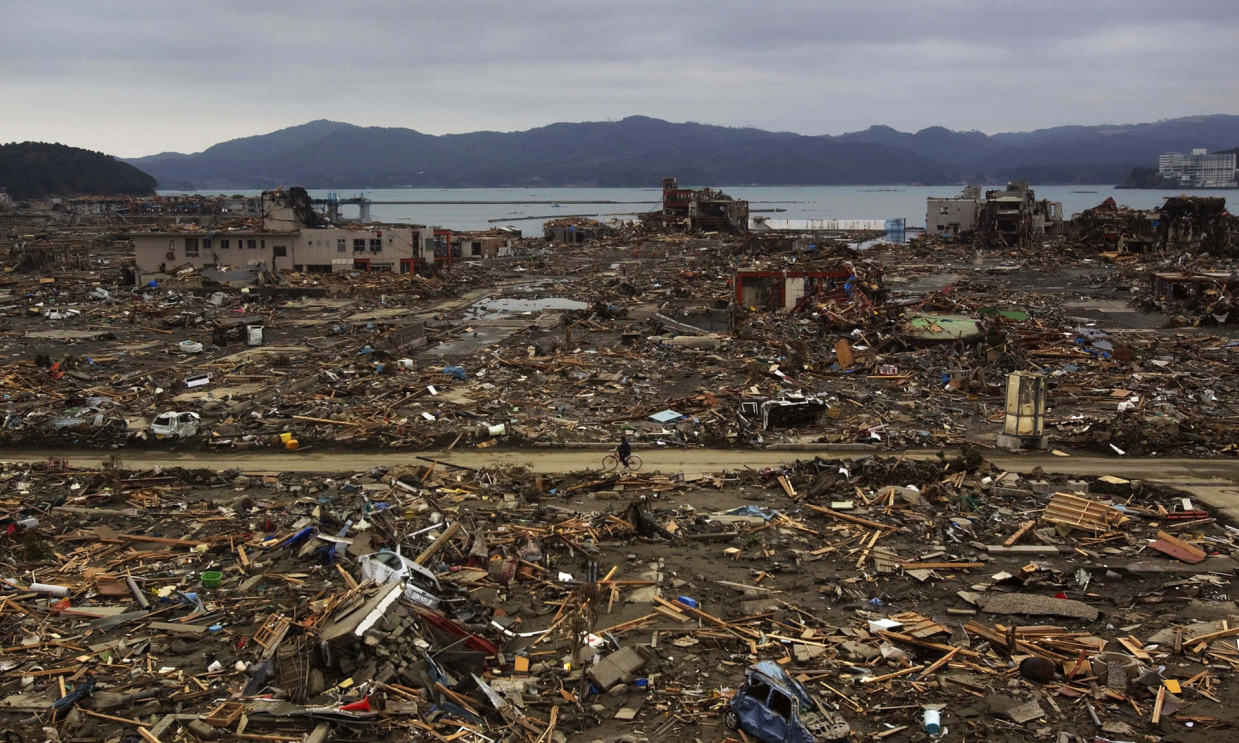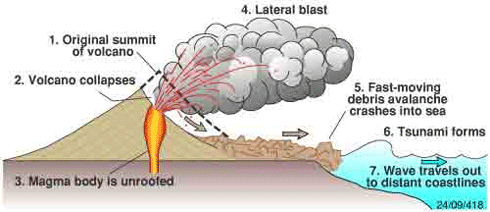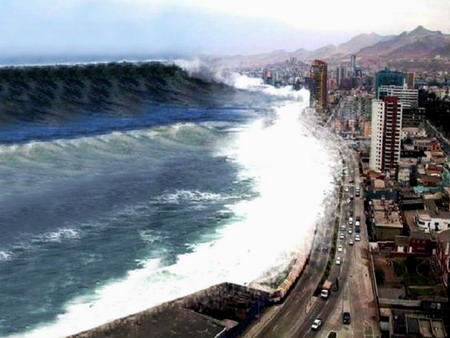
Tsunami is one of the most dangerous large-scale hazards. It is chosen as a primary topic for the essay, as it is the most hazardous and unpredictable natural phenomenon. Despite the rapid development of technology, a tsunami is variable. Moreover, a number of victims remain high, as the speed and development of the wave are high, and only some people can react quickly and evacuate from a dangerous zone. Consequently, a considerable magnitude and power of the wave destroys everything, which occurs on its way.
Figure 1 presents a devastating impact of the tsunami on the Japanese city, Minamasanriku (Japanese tsunami 2011). This disaster expectedly happened in 2011 (Reuters in Seattle 2015). The photograph displays the power and ability of the nature to destroy the whole city in a short period.
However, it has to be mentioned that this tsunami not only lead to the socio-demographic and economic problems, but also to the ecological issues. As some of the debris, such as electronics, car wrecks, and sports equipment still floats in the Pacific Ocean, the Ocean’s ecology is in danger (Reuters in Seattle 2015). Moreover, this fact causes problems to the United States of America, as some of the wreckages appear close to its coastline (Reuters in Seattle 2015).

As for the geoscientific origin of a tsunami, the process is complicated, as the intensity and magnitude depend on various parameters. Firstly, the source of the volcanic eruption has to be understood, as this natural phenomenon is one of the primary causes of a tsunami. Figure 2 displays the influence of volcanic eruption on tsunami formation (Volcanic eruption n.d.). A release of magma occurs due to the extreme density of magma and other gasses under the Earth’s crust (Masters 2012).
It could be seen high volumes of debris, which are crashing into the sea with the rapidly excavating speed (Volcanic eruption n.d.). This act causes a production of elevating capacities of energy aimed at the water surface. It is a primary cause of tsunami formation, as the pressure involves a movement of high volumes of water towards the shore. Even though a volcanic eruption is a leading cause of tsunami, the gigantic waves might occur due to the earthquakes and landslides.
The earthquake occurs due to the rapid release of accrued pressure in the crust of the Earth. A primary cause of it is ‘the relatively slow motion of lithosphere plates’ (Levin & Nosov 2009, p. 44). The epicenter of the earthquake takes place where a dislocation happens due to the remaining fault on the surface of one or more platitudes (Levin & Nosov 2009). As plates move, the surface of the Ocean experiences fluctuations and pressure, which leads to the tsunami development.
There are several types of tsunami regarding their geographical occurrence such as regional, local, and distant. Earthquakes generate all of these types (Mercado-Irizarry & Liu 2006). However, other geological changes such as volcano eruption might be considered as possible causes of this natural phenomenon. The local tsunamis have a travel time of maximum 24 minutes (Mercado-Irizarry & Liu 2006).
One of the examples of a tsunami is the disaster, which took place on Virgin Islands in 1867 (USC Tsunami Research Group 2005). Two waves crashed into the shore one after another with only ten minutes interval between them (USC Tsunami Research Group 2005). The population of the island was not able to respond quickly to the possible hazards. However, local tsunami attacks continue, as at the same time the island St. Croix was hit by two giant tsunami waves.
According to the eyewitnesses, the waves were around 7.6 meters high and caused severe damage to the island, as they were unexpected (USC Tsunami Research Group 2005). It could be concluded that local tsunamis are the most dangerous and are a reason for the significant amount of deaths, as the travel time of the wave is rather fast. In this case, the local government is illegible to contact and warn the inhabitants on time.

Regional and distant tsunamis are less dangerous, as they reach the coastline in more than 24 minutes (Mercado-Irizarry & Liu 2006). It could be said that regional tsunamis are less dangerous, as they affect only limited shorelines. However, even though the evacuation time is rather high, distant tsunamis are considered as the most hazardous one to the humankind. The destructive power is great, as the wave gains rapid speed from its generation until it crashes into the shoreline.
Furthermore, its detrimental effect continues to 1,000 kilometers from the epicenter (International Tsunami Information Center 2015). One of the example of distant tsunami aggression happened in the Indian Ocean in 2004 (International Tsunami Information Center 2015).
The primary cause of the massive tsunami was the earthquake of 9.8 magnitude (International Tsunami Information Center 2015). The power of the wave was so incredibly high, as it ruined a significant amount of settlements and caused death to thousands of people. Figure 3 displays the moment right before the shore get swallowed by the giant wave (Tsunami in the Indian Ocean 2013). The city seems tiny compared to the tsunami wave. The outcome is rather predictable, as the speed and height of the wave can be assumed.
In conclusion, it could be said that it is vital to understand a geological origin of a tsunami. There are two primary reasons for tsunami such as an earthquake and volcanic eruption. This knowledge will help avoid a big amount of victims after large-scale natural hazards. It could be said that tsunami is one of the most destructive natural forces, which exist on the planet Earth.
It could be understood from the pictures presented above that tsunami is a real danger for the humankind. With the high frequency of its occurrence, human beings and other animals could be vanished from the surface of the world.
Reference List
International Tsunami Information Center 2015, Tsunami classification.
Japanese tsunami. 2011, image. Web.
Levin, B & Nosov, M 2009, Physics of tsunamis, Springer Science + Business Media B.V., New York.
Masters, N 2012, Volcanic eruptions, Cherry Lake Publishing, North Mankato.
Mercado-Irizarry, A & Liu, P 2006, Caribbean tsunami hazard, World Scientific Publishing Co. Pte. Ltd., Singapore.
Reuters in Seattle 2015, ‘Japanese tsunami debris will continue to wash up on US shores, expert says’, The Guardian. Web.
Tsunami in the Indian Ocean. 2013, image. Web.
USC Tsunami Research Group 2005, The 1867 Virgin Island tsunami.
Volcanic eruption n.d., image. Web.